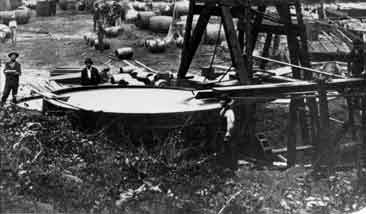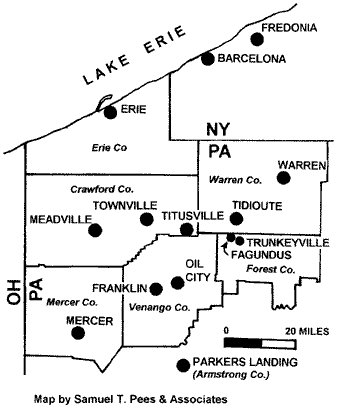 |
||||||
Wood and Metal Pipes
Wooden pipes were common before the oil booms of the 1860's and served mostly to carry water in farms and to domiciles but iron, lead and tin pipes were also greatly in use in cities and factories at that time. Some liquids in manufacturing or processing plants were carried in wooden pipes and also in wooden troughs on the premises such as was done with brine in the salt industry near Syracuse, New York, from the 1790's into the 1900's. Wooden pipes and gutters were used for some purposes around the oil wells in the earliest years of the first decade of oil (1860's) and at least one pipeline proposal in Oil Creek Valley planned to use wood (1861).
Wood pipe was used at a very early date in the natural gas industry. In 1821, gas from an excavated gas spring on Canadaway Creek in Fredonia, N.Y. was conveyed in a wood pipe to a nearby user and sold on a burner basis (30 burners were supplied). In 1823, gas found bubbling up through joints in the organic shale cropping out along the south shore in Lake Erie was captured and piped to the Barcelona Harbor lighthouse through pine logs (Oil & Gas Journal, Derrick, 1934). There were other early gas occurrences in the Appalachian basin that were utilized by piping through wood pipes.
An 1862 photo of well Phillips No. 2 on the Tarr Farm, Oil Creek Valley shows crude oil being fed into a large wooden storage tank via a trough made of two boards nailed snuggly together to form a V while the top of the V was covered by a plank. The photograph also shows iron pipe (tubing) in use at the same well.
In the narrow muddy flat along a tributary of Oil Creek the writer found joints of seven foot eight inch (probably variable lengths) wooden pipe that had been milled (to have a male end) and were wound with spirals of loosely spaced iron bands as well as coated on the outside with asphalt or similar bituminous substance. The outside diameter varied from 7-1/2 to 5-1/2 inches due to tapering. These wooden pipes were located in a heavily drilled area and may have been used for oil purposes, but no trace of oil was left in the pipes. They could have served the nearby railroad stations of the day (Miller Farm and Shaffer) or might have been used by the local lumber plants. No study has been done of this wooden pipeline. It is presumed that the pipes date to the 1860's-70's. One point of view is that they conveyed water (but the stream was doing that anyway).
In 1972 the writer attended an auction of the merchandise of the old Hanna Hardware Store in Townville which is near the NW Pennsylvania oilfields. A large number of square joints of wooden pipe (the round hole was drilled in the center) were among the items sold. These had probably been on the shelf for many years.
Cast iron and wrought iron pipes of various diameters were in use around the producing wells from the start of the industry. The pipes variously served as drive pipe, conductor, casing, tubing and for conveyance of oil in and around the lease. Wooden troughs for passing oil to tanks or flatboats on the nearby creek were common too.
|
||
|
||
|
| © 2004, Samuel T. Pees all rights reserved |
|


